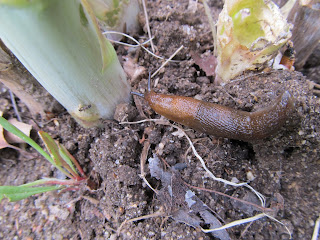Weather-wise it has been a great Spring for asparagus. We have had very few hot days and adequate rainfall. At the beginning of May it looked like this was going to be my best year yet for harvesting my favorite vegetable.
 |
| The asparagus in May were tender and plentiful |
|
|
|
 |
| Deformed asparagus spears. |
However, after a couple pickings, it became apparent that something was wrong. The asparagus became deformed and seemed to be rotting shortly after emerging from the soil. At the same time I began to notice asparagus beetles on the ground and on the plants. In the past I have dealt with asparagus beetles after harvesting is over and the plants have gone to seed. This year I learned that there are two different asparagus beetle pests. The earlier arrival is the common asparagus beetle, or
Crioceris asparagi. This beetle arrives as soon as the spears start emerging from the soil and they are extremely destructive. As I looked around the deformed stalks, I saw the beetles crawling on and around the soil. Close up the beetles are colorful, being orange, yellow and black with a geometric pattern on its wings.
 |
| Common Asparagus Beetle |

Although I have seen the beetles and their eggs, I have not yet seen any larvae, which is a good. I try to go out daily picking off the beetles and tossing them in a bucket of soapy water and rubbing my fingers along the stalks to remove the eggs. Although it seems like a futile exercise since just as many beetles appear the next day, I know that if I don't do this the numbers will increase and the damage to the plants may severely impact the plants survival and it's ability to produce new spears next year. The second beetle to arrive is the spotted asparagus beetle or
Crioceris duodecimpunctata. I noticed a few this morning. They have arrived right on schedule, about three weeks after the common asparagus beetle
. The photo at left shows a pair of spotted asparagus beetles mating. The life cycle of asparagus beetles is between 23 and 37 days with three generations born in a year. Interrupting this cycle as much as possible is key to keeping populations under control.
I have learned that the adult beetles will overwinter in the hollow stems of old asparagus plants. This fall I will make sure that once the plants are no longer green, to cut the stalks down to ground level.
Unfortunately, beetles are not my only worry for the asparagus plants. In the beginning of May, I realized that I also have a slug problem.
 |
| Where does this slug think it's going? |
|
 |
| Probably right inside. |
|
I have not noticed them in the past couple of weeks, so hopefully, now that temperatures have warmed, the moist conditions that encourage slugs will be diminished. I will also avoid watering in the evening, physically remove these creatures when I find them (although picking off beetles is more palatable than removing sticky slimy slugs), and space my plantings to encourage adequate air flow. Hopefully Mother Nature will cooperate as well with weather that is not too cool or damp.



 Although I have seen the beetles and their eggs, I have not yet seen any larvae, which is a good. I try to go out daily picking off the beetles and tossing them in a bucket of soapy water and rubbing my fingers along the stalks to remove the eggs. Although it seems like a futile exercise since just as many beetles appear the next day, I know that if I don't do this the numbers will increase and the damage to the plants may severely impact the plants survival and it's ability to produce new spears next year. The second beetle to arrive is the spotted asparagus beetle or Crioceris duodecimpunctata. I noticed a few this morning. They have arrived right on schedule, about three weeks after the common asparagus beetle. The photo at left shows a pair of spotted asparagus beetles mating. The life cycle of asparagus beetles is between 23 and 37 days with three generations born in a year. Interrupting this cycle as much as possible is key to keeping populations under control.
Although I have seen the beetles and their eggs, I have not yet seen any larvae, which is a good. I try to go out daily picking off the beetles and tossing them in a bucket of soapy water and rubbing my fingers along the stalks to remove the eggs. Although it seems like a futile exercise since just as many beetles appear the next day, I know that if I don't do this the numbers will increase and the damage to the plants may severely impact the plants survival and it's ability to produce new spears next year. The second beetle to arrive is the spotted asparagus beetle or Crioceris duodecimpunctata. I noticed a few this morning. They have arrived right on schedule, about three weeks after the common asparagus beetle. The photo at left shows a pair of spotted asparagus beetles mating. The life cycle of asparagus beetles is between 23 and 37 days with three generations born in a year. Interrupting this cycle as much as possible is key to keeping populations under control.

No comments:
Post a Comment